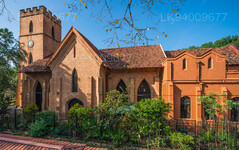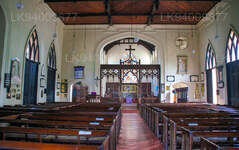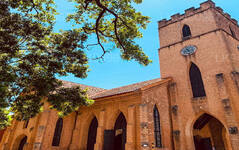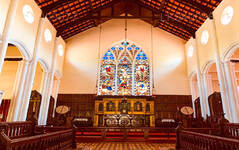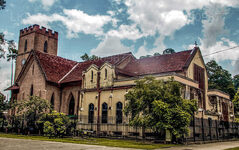
Ville de Kandy
Kandy, ville pittoresque du centre du Sri Lanka, est réputée pour son riche patrimoine culturel, ses festivals dynamiques et la beauté de ses paysages. Nichée au cœur de collines verdoyantes, elle abrite le Temple de la Dent, classé au patrimoine mondial de l'UNESCO, et offre un mélange captivant d'histoire et de splendeur naturelle.
St Pauls Church
St Paul’s Church is an Anglican Church located in an area called Milagiriya in Colombo 04, Sri Lanka. It has its origins in the Portuguese era of the 16th century. Today it is one of the oldest and most historic churches within Colombo and is also well known due to the attached girls’ school. Here’s the story of how it came to be:
The Early Portuguese Church
Over four centuries ago, when the Portuguese invaded Sri Lanka – they caused mass destruction to the local religions and built Roman Catholic Churches to spread their discipline of Christianity. It is unknown why they chose to build a church at that specific location, but perhaps there may have been some sort of locally popular shrine there that they destroyed and built over – as was their habit.
The newly built church, at the time, was known as ‘Nossa Senhora dos Milagres’ or ‘Our Lady of Miracles’. The locals, due to their lack of knowledge and understanding about the Portuguese language, took to calling the church ‘Milagres’, which is actuality meant ‘Miracles’. With time the name evolved, and the entire area surrounding the church came to be known as ‘Milagiriya’.
The British Takeover
However, the ‘Church of Miracles’ did not last. Approximately a century later, Ceylon was invaded by the Dutch who suppressed the Portuguese and wrested control of the valuable trade route island from them. To consolidate their rule, the Dutch thoroughly destroyed all Portuguese monuments and churches that they could find. Nossa Senhora dos Milagres was one of these churches that fell under their hands. The consecrated land remained bare for over a century, until the British decided to invade and took control of Sri Lanka from the Dutch.
The Building of St Paul’s
In the 1840s, a large number of Anglican churches started to get constructed. The premise behind them was mainly to give places of worship for British countrymen, but also to persuade the native population to change their religion and follow the Anglican discipline.
St Paul’s Anglican Church, which was built over the ruins of the old Portuguese church in Milagiriya, was one such church built by the British. The construction of the church began in 1948 under the initiation of the British cleric, Reverend Joseph Thurston, who dedicated it to St Paul. It was completed in 1953 and consecrated by the Bishop of Colombo at the time. An attached industrial school was also built at the same time to give a place of learning for Anglican youth. However, the main attraction was the font within the church grounds, hailing from the time of the previous Portuguese church. Its water was said to have miraculous healing properties, and sick people from all over the country visited the church to experience this healing.
Between the 1890s to the early 1900s, the church flourished and many locals joined the congregation as well. This was also partly due to the efforts of the first two vicars, Rev. John Ford and Rev. Harry Marsh ,who worked within the neighborhood to help the natives at their times of need.
A Change in Leadership
In the early 1900s, with the arrival of the First World War, the British began losing interest in Sri Lanka. Many Englishmen and other Europeans left the island, returning to their home countries or moving to the newly settled land of Australia. The leadership of St Paul’s fell into the hands of the elite and influential members of the congregation, and the very first native Sri Lankan Vicar for the church was elected in 1920. Rev. Paul Lucien Jansz took up official duties as the third vicar of St. Paul’s, and continued till 1953.
In the meantime, the Second World War occurred in the 1940s and the British lost much of their troops. It spelled the death knell to Britian’s supremacy over the countries in the East and Far East. They gave independence to most of those countries that they had established a rule over, and returned back to England or went to Australia. By the 1950s and 1960, when Rev Jansz ended his term as the vicar of St Paul’s, there were little to no British clergy left to take over the office and the vicarage continued to be passed over to Sri Lankans – fulling transferring the leadership to native hands.
The Church as it is Today
Today St. Paul’s Church in Milagiriya comes under the Church of Ceylon, the main Anglican Church in Sri Lanka, and is part of the diocese of the Archbishop of Canterbury. The vicars throughout the years continued to grow and develop the church, making it extremely popular amongst the Colombo population. Today the congregation consists of a large mixed crowd of individuals: Sinhalese, Tamils, Burghers, and Europeans who stay in Sri Lanka for longer periods.
The church itself resembles a Greek Basilica. Five services occur on Sunday in the church’s chapel in the left wing, named ‘Chapel of our Lady’, where the original 19th century altar still remains. The miraculous font is still popular and visited by many church goers. The attached school that once was a place of industrial learning, was converted into a government managed learning institution for girls and became known as St. Paul’s Girls School, Milagiriya. The most recent renovations to the church added a service center for children and adults.
St Paul’s often community activities for disadvantaged children. They run a home for disabled children in the region of Mayura Place in Havelock Town. There is also a project done by the church that benefits children from the slums near the stations of Colombo 4 and Colombo 6.
The church also maintains links to congregation members who migrate abroad and churches from other countries. This provides them a global perspective that which they then implement among the local community.
Today any visitor is warmly welcomed by the vicar and/or clergy, and can take part in the services and community activities of the church if they wish to. The vicar is also quite happy to give further insights to the history of the church and point out places of interest within the church grounds. So it’s definitely a peaceful and interesting place to go to if you’re in Colombo.
À propos du district de Kandy
Le district de Kandy est situé dans la province centrale du Sri Lanka. L'un des sept sites du patrimoine mondial du Sri Lanka, Kandy était autrefois la demeure des rois kandyans d'antan au XVIe siècle et une source de toute la musique, des arts, de l'artisanat et de la culture du pays. À environ 129 km de Colombo, Kandy est nichée au cœur d'un terrain vallonné et tous les regards sont attirés par le centre de la ville, où le lac Kandy forme un élément charmant. Kandy conserve une grande importance religieuse pour le Sri Lanka, car c'est dans cette charmante ville que se trouve le Dalada Maligawa ou « Temple de la Dent », dans lequel la relique sacrée de la dent du Seigneur Bouddha est bien gardée.
Le Jardin botanique royal de Peradeniya est situé à environ 5 km à l'ouest du centre-ville et accueille 1,2 million de visiteurs chaque année. C'est le plus grand jardin botanique de l'île. L'Udawatta Kele (forêt d'Udawatta) est un sanctuaire protégé situé au cœur de la ville, juste au nord du Temple de la Dent. Kandy est une ville à majorité cinghalaise ; on y trouve d'importantes communautés appartenant à d'autres groupes ethniques, comme les Maures et les Tamouls. Kandy est le deuxième centre économique sri-lankais après Colombo. De nombreuses grandes entreprises y ont des succursales et de nombreux secteurs d'activité, comme le textile, l'ameublement, les technologies de l'information et la bijouterie, y sont implantés. De nombreux centres de recherche agricole sont implantés dans la ville.
Et une source d'inspiration pour toute la musique, les arts, l'artisanat et la culture du pays. À environ 129 km de Colombo, Kandy est nichée au cœur d'un paysage vallonné et tous les regards se tournent vers le centre-ville, où le lac de Kandy forme un attrait charmant. Kandy conserve une grande importance
religieuse pour le Sri Lanka, car c'est dans cette charmante ville que se trouve le Dalada Maligawa, ou Temple de la Dent, où repose la relique sacrée de la dent du Bouddha.
À propos de la province centrale
La province centrale du Sri Lanka est principalement constituée de montagnes. D'une superficie de 5 674 km², elle compte 2 421 148 habitants. Parmi les principales villes figurent Kandy, Gampola (24 730 habitants), Nuwara Eliya et Bandarawela. La population est un mélange de Cinghalais, de Tamouls et de Maures. Kandy, capitale des collines, et Nuwara Eliya, ainsi que Sri Pada, se trouvent toutes deux dans la province centrale. La province produit une grande partie du célèbre thé de Ceylan, planté par les Britanniques dans les années 1860 après qu'une épidémie dévastatrice eut décimé toutes les plantations de café de la province. La province centrale attire de nombreux touristes, avec ses stations de montagne comme Kandy, Gampola, Hatton et Nuwara Eliya. La dent du Temple, ou Dalada Maligawa, est le principal lieu sacré de la province centrale.
Kandy, capitale des collines, et Nuwara Eliya, ainsi que Sri Pada, sont situées dans la province du Centre. La province produit une grande partie du célèbre thé de Ceylan, planté par les Britanniques dans les années 1860 après qu'une maladie dévastatrice eut détruit toutes les plantations de café. La province du Centre attire de nombreux touristes, avec ses stations de montagne comme Kandy, Gampola, Hatton et Nuwara Eliya. La dent du Temple, ou Dalada Maligawa, est le principal lieu sacré de la province du Centre. Le climat est frais et de nombreuses régions situées à environ 1 500 mètres d'altitude connaissent souvent des nuits fraîches. Les versants occidentaux sont très humides, avec près de 7 000 mm de précipitations par an à certains endroits. Les versants orientaux font partie de la zone semi-sèche, car ils ne reçoivent les pluies que lors de la mousson du nord-est. Les températures varient de 24 °C à Kandy à seulement 16 °C à Nuwara Eliya, située à 1 889 m d'altitude. Les plus hautes montagnes du Sri Lanka se trouvent dans la province centrale. Le relief est principalement montagneux, sillonné de profondes vallées. Les deux principales régions montagneuses sont le massif central et la chaîne des Knuckles, à l'est de Kandy.

